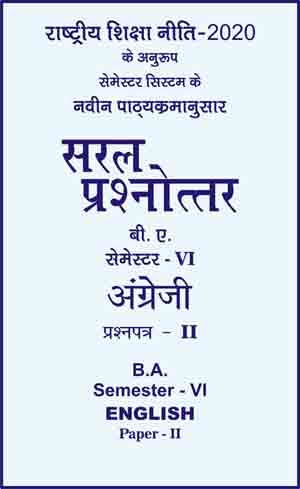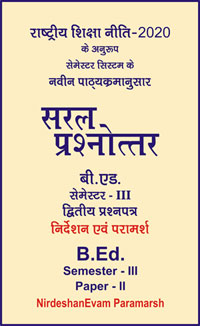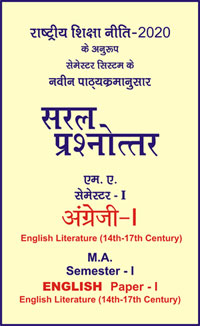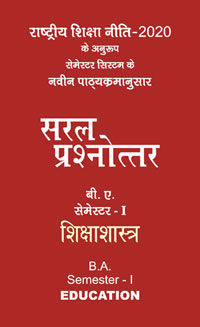|
बी ए - एम ए >> बीए सेमेस्टर 6 अंग्रेजी पेपर 2 बीए सेमेस्टर 6 अंग्रेजी पेपर 2सरल प्रश्नोत्तर समूह
|
|
||||||
बीए सेमेस्टर 6 अंग्रेजी पेपर 2
Objective Type Questions
For each of the following questions, four alternatives are given for the answer. Only one of them is correct. Choose the correct alternative.
-
What is the primary role of a news anchor in radio broadcasting?
(a) Reporting from the field
(b) Editing audio clips
(c) Delivering news to the audience
(d) Writing news scripts -
Which of the following is essential for writing radio news scripts?
(a) Complex vocabulary
(b) Visual descriptions
(c) Conversational tone
(d) Long sentences -
What does ‘live reporting’ in radio refer to?
(a) Prerecorded news
(b) Reading news from a script
(c) Broadcasting news as events happen
(d) Playing recorded interviews -
In radio, the term ‘actuality’ refers to:
(a) Fictional stories
(b) Live interviews
(c) Recorded real-life sounds or voices
(d) Background music -
Which of these is a key skill for radio reporters?
(a) Graphic design
(b) Clear and engaging voice
(c) Video editing
(d) Photography -
What is the purpose of sound effects in radio news?
(a) To fill time
(b) To enhance understanding and engagement
(c) To replace music
(d) To increase the news duration -
Why is immediacy important in radio news?
(a) It allows for longer stories
(b) It offers real-time information to listeners
(c) It reduces production costs
(d) It uses less bandwidth -
What is the role of a ‘content producer’ in radio?
(a) Managing the technical equipment
(b) Selecting and organizing program content
(c) Writing scripts for news
(d) Voicing advertisements -
Which of the following is a characteristic of good radio news reporting?
(a) Subjectivity
(b) Bias towards a viewpoint
(c) Impartiality and accuracy
(d) Emphasis on visuals -
In radio, ‘dead air’ refers to:
(a) Time for commercials
(b) Time when no sound is broadcast
(c) End of a news segment
(d) Time allocated for music -
What does ‘vox pop’ stand for in radio journalism?
(a) Voice of the people
(b) Popular voice
(c) Voice projection
(d) Voice of the presenter -
The term ‘fade in’ in radio production refers to:
(a) Stopping the broadcast
(b) Gradually increasing the volume of a sound
(c) Switching between channels
(d) Starting the news bulletin -
What is an ‘RJ’ in radio terminology?
(a) Radio Jockey
(b) Radio Journalist
(c) Radio Judge
(d) Radio Juggler -
Which of these is crucial for effective radio interviews?
(a) Using technical jargon
(b) Reading from a script
(c) Engaging and dynamic questioning
(d) Long monologues -
What is the main purpose of a news bulletin in radio?
(a) To entertain listeners with music
(b) To provide updated and summarized news
(c) To advertise products
(d) To present radio dramas -
A ‘sound bite’ in radio is:
(a) A lengthy speech
(b) A short excerpt from a speech or interview
(c) Background noise
(d) A musical interlude -
What does ‘segue’ mean in radio broadcasting?
(a) Ending a program
(b) A smooth transition from one element to another
(c) A technical error
(d) A news headline -
The term ‘field reporting’ in radio refers to:
(a) Reporting from a sports field
(b) Reporting from the radio studio
(c) Reporting from an external location
(d) Reporting on agricultural news -
In radio, a ‘bed’ is:
(a) A place for resting
(b) Background music or sound under a voice
(c) A type of microphone
(d) A segment for sleep-related topics -
What is the primary purpose of a radio ‘teaser’?
(a) To give a brief preview of upcoming content
(b) To play music between news segments
(c) To fill extra time -
Which element is not typically included in a radio news script?
(a) Detailed descriptions
(b) Key facts and figures
(c) Quotes or sound bites
(d) Clear, concise language -
‘Public service announcements’ on radio are intended to:
(a) Promote commercial products
(b) Provide information for the public good
(c) Entertain listeners
(d) Present celebrity interviews -
What does ‘AM’ stand for in radio broadcasting?
(a) Afternoon Music
(b) Amplitude Modulation
(c) Audio Media
(d) Assigned Messaging -
‘Talkback’ in radio refers to:
(a) The host talking back to guests
(b) Audience calling in to participate
(c) Repeating a segment
(d) Background discussion -
In radio news, the ‘inverted pyramid’ style is used to:
(a) Start with the least important information
(b) Present information in chronological order
(c) Begin with the most important information
(d) Confuse the listeners
|
|||||

 i
i 









